Job Growth & Unemployment
Posted on 10/25/2016 by Chris Ramser
- Austin added 28,900 net new jobs, growth of 3.0%, in the 12 months ending in September, making Austin the ninth fastest growing major metro.
- Professional and business services added the most jobs (6,000 or 3.7%) in the past year, however, the fastest growing industries are wholesale trade (8.8%) and construction and natural resources (8.6%).
- Austin's seasonally adjusted unemployment rate is 3.4%, up from 3.3% in August.
The Austin metropolitan area added 28,900 net new jobs, or 3.0%, in the 12 months ending in September, according to Friday's release of preliminary payroll jobs numbers by the Texas Workforce Commission (TWC) and the U.S. Bureau of Labor Statistics (BLS).

Austin’s 3.0% growth makes it the ninth best performing among the 50 largest metro areas. Orlando topped the ranking by growing at 4.7%, while Jacksonville was second with growth of 4.6%. Dallas, at 4.2%, was the fourth fastest growing job market behind third place Fort Lauderdale. The other three major Texas metros missed the top 10. San Antonio grew by 2.1% (28th), Fort Worth also grew by 2.1% (30th), and Houston grew by 0.7% (47th) between September 2015 and September 2016.
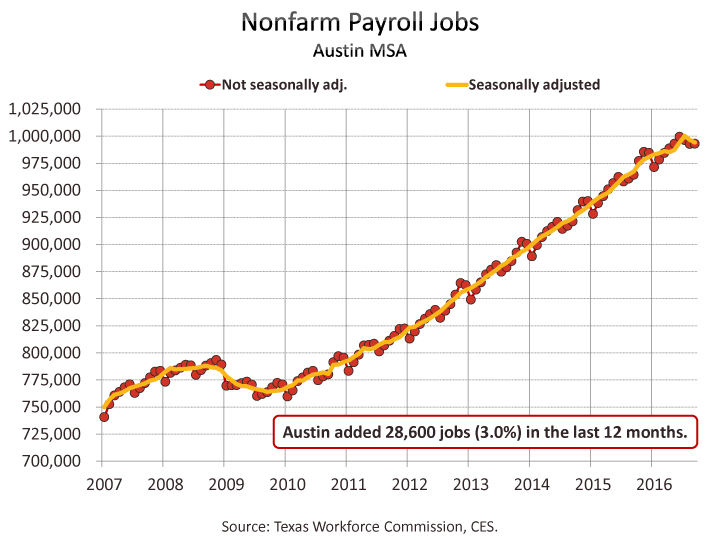
For the year ending in September, private sector job growth in the Austin MSA is 3.2%, or 25,600 jobs, and with all private industry divisions, except manufacturing, contributing to the growth. Austin's sizable government sector (nearly 18% of jobs) saw modest growth over the last 12 months, gaining 3,000 jobs or 1.8%, thus bringing the overall job growth rate to 3.0%.

Texas saw weaker net private sector job growth of 1.7% with nine of eleven private industry divisions adding jobs over the last 12 months. The government sector, which accounts for over 16% of total state employment, grew faster, 2.2%. Overall job growth was 1.7%. For the nation, private sector growth is 1.9% for the 12 months ending in September, with all private industries, but manufacturing, adding jobs. Overall job growth is a more modest 1.7% because the government sector gained only 0.7%.

Jobs in September are essentially unchanged from August — up by only 200 jobs or 0.0% in the not-seasonally-adjusted series for Austin. Job change from August to September is down in the seasonally adjusted series by 2,600 or 0.3%. Each of the other major Texas metros had positive seasonally adjusted job change over the last month with San Antonio leading the way with 0.7% growth, followed by Dallas, 0.5%, Fort Worth, 0.3%, and Houston, 0.2%. Statewide, seasonally adjusted jobs are up 38,300 or 0.3% in September. Nationally, seasonally adjusted jobs are up 0.1%.
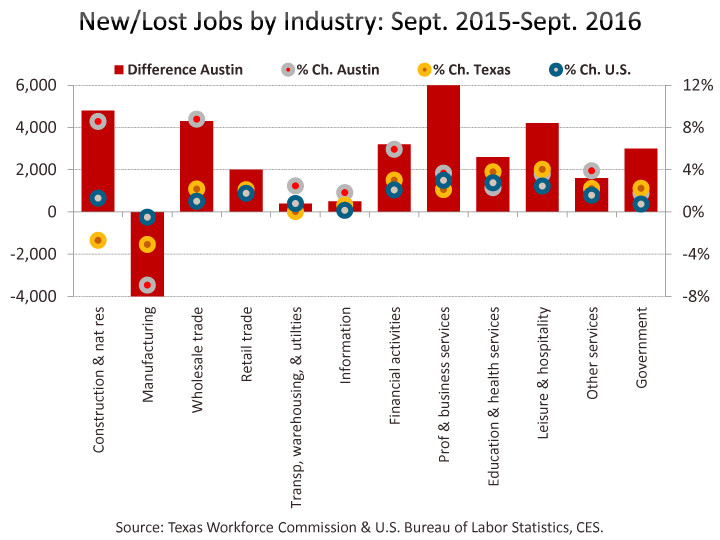
In Austin, the industry adding the most jobs over the last 12 months is professional and business services which grew by 6,000 jobs, or 3.7%. Wholesale trade grew fastest at 8.8% (4,300 jobs), followed by construction and natural resources at 8.6% (4,800). Also growing at a faster-than-average rate are financial activities at 5.9% (3,200 jobs), other services at 3.9% (1,600), and leisure and hospitality at 3.6% (4,200). Manufacturing lost 6.9% or 4,000 jobs. [For a look at the last decade of these industries' growth in Austin compared to the state and the nation, click on the embedded links in this paragraph.]
Statewide, leisure and hospitality grew fastest, 4.0%, and added 51,000 jobs. Education and health services added the most jobs, 60,700 jobs and grew 3.8%. The other relatively fast growing private industries include financial activities (3.0%), wholesale trade (2.2%), and professional and business services and retail trade (both growing 2.1%). Jobs in manufacturing declined by 26,800, or 3.1%, and construction and natural resources lost 25,500 jobs, or 2.7% over the last 12 months.
Nationally, professional and businesses services grew fastest, adding 3.0% over the 12 months ending in September. The other industries growing at faster-than-average rates were education and health services (2.8%), leisure and hospitality (2.4%), and financial activities (2.1%). Manufacturing jobs declined by 0.5%.

The net gain for private service-providing industries in Austin is 24,800 jobs, or 3.6%, over the last 12 months. Employment in goods producing industries is up by 800 jobs or 0.7%. Statewide, private service-providing industries are up 218,500 or 2.7%, but goods producing industries are down 52,300 jobs or 2.9%.
We also now have August labor force, employment, and unemployment numbers for Texas and local areas in Texas. The same data for all U.S. metros that we often do a ranking of will not be released until November 2. In August, Austin had the fifth lowest rate of unemployment among the 50 largest metros.
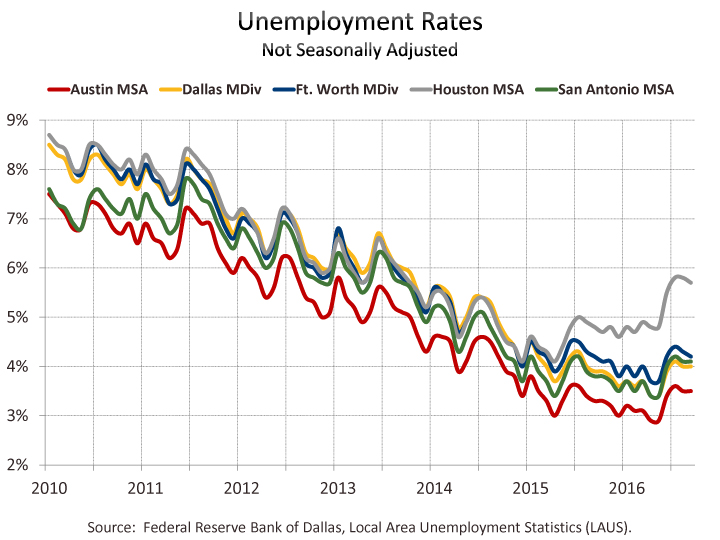
Unemployment numbers for September show Austin’s performance relative to the state and other major Texas metros being sustained. In September, Austin is at 3.5%, while the other major metros range from 4.0% in Dallas to 5.7% in Houston. San Antonio is at 4.1% and Fort Worth is at 4.2%. Fort Worth’s rate is unchanged from a year ago. Austin’s rate was 3.3% a year ago. Dallas, Houston and San Antonio also had lower rates in September of last year (3.9%, 4.8% and 3.8% respectively).
In July and August, Texas and the nation shared the same not-seasonally-adjusted unemployment rates, 5.1% in July and 5.0% in August. This month, Texas improves to 4.9%, however, the national rate has fallen to 4.8%. The last time Texas’ unemployment rate exceeded the national rate was in November 2006. Texas’ current rate is up from 4.5% in September 2015, while the U.S. rate is improved from 4.9%.
In 2007, before the impact of the Great Recession, unemployment averaged 3.6% in Austin, 4.3% in Texas, and 4.6% nationally. Unemployment has been at or below pre-recession levels for 20 months in Austin. Texas’ year-to-date average (4.6%) is above what it averaged in 2007. The nation, with unemployment averaging 5.0% in 2016, has yet to regain its pre-recession level of unemployment.
Within the Austin MSA, Travis County has the lowest unemployment rate in September, at 3.4%, while Caldwell County has the highest at 4.5%. The rate is 3.6% in Williamson County, 3.7% in Hays County, and 3.9% in Bastrop County.

On a seasonally adjusted basis, Austin’s September unemployment rate is 3.4%, up from 3.3% in August. The statewide rate is 4.8%, up from 4.7% in August. Nationally, the seasonally adjusted unemployment rate is 5.0%, up from 4.9% in August.
Among Texas’ major metros, Fort Worth shares Austin’s 3.4% seasonally adjusted rate, while San Antonio, Dallas, and Houston are at 3.8%, 4.7%, and 5.1% respectively. As with Austin, September rates are up from August in Dallas and Houston, however Fort Worth’s rate is improved and San Antonio is unchanged. Seasonally adjusted unemployment rates for Texas metros are produced by the Federal Reserve Bank of Dallas. (The TWC also produces seasonally adjusted rates for Texas metros, but publication lags the Dallas Fed’s data.)

With Austin’s unemployment rate elevated from the rate one year ago, the number of unemployed is up by 3,221 or 9.0%. In September 2016, Austin’s number of unemployed is 39,139, up from 35,918 a year ago. The number of unemployed in Austin averaged more than 60,000 for three years running during the Great Recession.
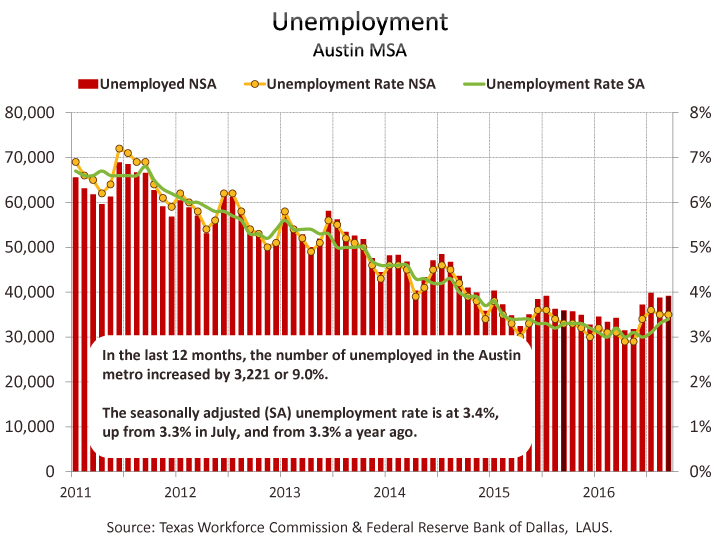
The Austin metro’s civilian labor force (employed plus unemployed) has increased by 3.4% or 36,455 persons from one year ago, while persons employed increased by 3.2% or 33,234. Texas saw 2.7% growth in labor force and 2.2% in employed, while the number unemployed increased by 12.8% or 75,337. Nationally, September civilian labor force is up by 1.9%, while employed is above the level of a year ago by 2.0%, and 30,000 fewer people (0.4%) are unemployed.
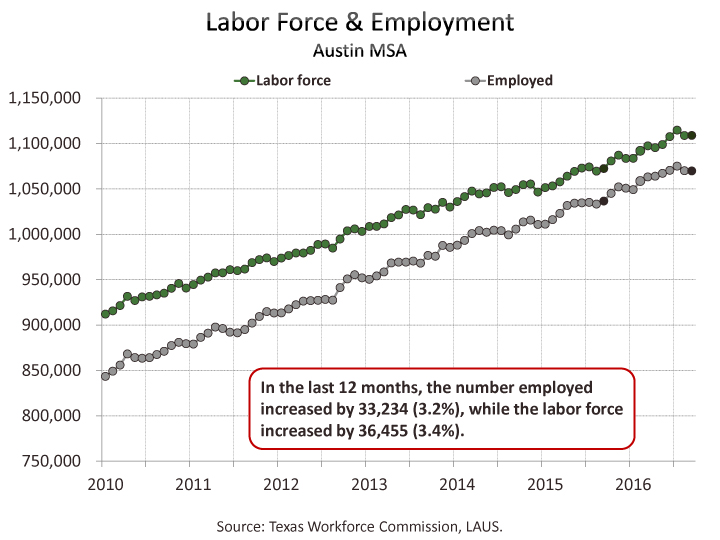
Texas Workforce Commission will release October estimates on November 18.
The Chamber’s Economic Indicators page provides up-to-date historical spreadsheet versions of Austin, Texas and U.S. data for both the Current Employment Statistics (CES) and Local Area Unemployment Statistics (LAUS) data addressed above.
Related Categories: Central Texas Economy in Perspective